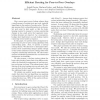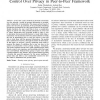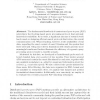167 search results - page 16 / 34 » About the Lifespan of Peer to Peer Networks |
NSDI
2004
13 years 10 months ago
2004
Most current peer-to-peer lookup schemes keep a small amount of routing state per node, typically logarithmic in the number of overlay nodes. This design assumes that routing info...
JCP
2007
13 years 8 months ago
2007
— Every time a user conducts an electronic transaction over the Internet a wealth of personal information is revealed, either voluntarily or involuntarily. This causes serious br...
DASFAA
2005
IEEE
14 years 2 months ago
2005
IEEE
The fundamental drawback of unstructured peer-to-peer (P2P) networks is the flooding-based query processing protocol that seriously limits their scalability. As a result, a signi�...
EPEW
2005
Springer
14 years 2 months ago
2005
Springer
Choreography languages provide a top-view design way for describing complex systems composed of services distributed over the network. The basic building block of such languages is...
P2PKM
2004
13 years 10 months ago
2004
We present RDFGrowth, an algorithm that addresses a specific yet important scenario: large scale, end user targeted, metadata exchange P2P applications. In this scenario, peers per...



